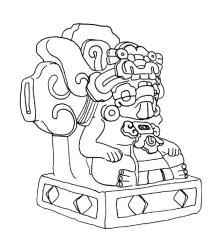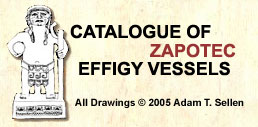| Key: MCO 0679 | | Actual Location: Museum of Cultures of Oaxaca, Oaxaca, Mexico. | | Registration: 10-1043225 INAH / cm.ROA 0679 | | Provenance: Mound YW, well 1, offering 2, No. 8, Monte Albán, Oaxaca. | | Measurements: 23 cm. | | Chronology: Early MA IIIB (Caso 1938: 19); Peche 500 - 600 AD | | Click to view Chronology | | Reference: Caso 1938: 19, fig. 27; Caso & Bernal 1952: 47, fig. 64; Caso et al. 1967: 125, fig. 79. | | Comments: The shapes in the throne have been opened on the sides and it seems this was done on purpose to be able to decorate the piece with feathers, plants or other objects. In the upper part of the throne, there are also holes to allow the decoration of the piece. Caso says that this piece was found as an offering to Stelae 16 (Caso 1938: 19). Skulls of birds and a "very dark" soil were found inside the piece (Caso, Bernal y Acosta 1967: 127). This piece was found next to another urn (see MNA Mont. Y.W.of.2-2). Both were covered with broken pieces of earthenware and flat stones to protect them. Compare with ROM 1936, MFR s/n 6, SMI 115002, UPM 29-41-707 and KERR 6460. | | Glyphs: Glyph C in the headdress. The glyph for corn grain in the throne's dossal. | |
| | 
Click to view high resolution in a new window
select this image for review |
